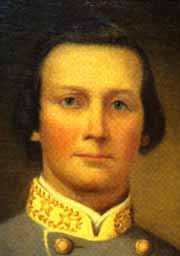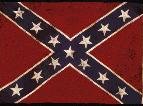The brigade having been ordered from the left of the corps at one p.m. to the extreme right, was placed in position by the lieutenant-general in person on the right and east of the railroad, the left resting on the railroad cut, which at that point was some eight or ten feet deep, the formation of the brigade being in one rank. Our line ran through a thick undergrowth and wood near the railroad and was entirely without fortifications. The second Battalion Georgia Sharpshooters, Major Whiteley, occupied the left of the brigade, resting in the railroad cut, and the Twenty-fourth came next, the Sixteenth South Carolina next, and the Forty-sixth Georgia on the right. Lieutenant-General Hardee directed me to make my position as strong as possible, and told me that he relied upon our brigade to hold the right of his line. The men climbed up the small trees, bent them over and using pocket knives to cut across the trunks, succeeded in half an hour in making a first rate abatis of little trees, interlaced thickly and held by half their thickness to the stumps. Along my line I brought up rails and logs from the rear and made a tolerable breast-work. As we were bent back to cover the right of the corps the direction of my line exposed us to an enfilade from the other side of the railroad cut, and to protect my companies against this I built traverses of logs on the left of my left companies. These proved our salvation. Rapid firing began in my front about four o’clock, and in half an hour my skirmishers came in, closely followed by the assaulting line of the enemy. The assault seemed directed mainly against the positions on the right and left of the railroad and only reached to the center of the Twenty-fourth. It was handsomely repulsed, Major D.F. Hill directing the fire of the companies on the left with splendid effect. Again at 5:30 o’clock the enemy moved forward along the entire front of the Twenty-fourth. I fired by rank, and rapidly, and the movement was checked.; but on the west side of the railroad the firing was heavy and the fighting continuous , and I soon saw that the position on that side had been carried, the enemy occupying the works. Unfortunately the battalion of sharpshooters was retired just at this moment without orders from brigade headquarters, and the enemy promptly moved up on our side and occupied Whiteley’s works, firing wildly over my left now protected by my traverses. During this fire Hill was killed and many of our men wounded. An assault being made from the front, Companies B (Lieutenant Easterling), G (Lieutenant Beckham), and K (Lieutenant Seigler), were driven from my left after a gallant stand. Beckham being nearest me I ordered him to rally his company at once and retake his place before it would be too late. He responded with his usual gallantry, and assisted by yourself and my adjutant, Lieutenant Holmes, I rallied my men, and we retook our position, occupying the traverses on the left. For the gallant assistance offered by yourself and by Lieutenants Holmes, Beckham , and Easterling in effecting this I felt myself greatly indebted. Seeing the urgent necessity of driving the enemy from the position of the Sharpshooters, which brought them right on us, Major Smith and Lieutenants, Beckham and Easterling charged them with Companies B and G, and after a close fight drove them entirely out of our works. Meanwhile Major Whiteley brought up his battalion and reoccupied his position in the railroad cut. Companies B, G, and K, now resumed their place in line, and the firing lulled, the enemy in my front retiring to the bottom of the hill. While we were fighting on the left, Lieutenant Colonel Jones directed the firing of the center and right of the Twenty-fourth, and repulsed every assault of the enemy. It is to be noted that the assault did not reach the two regiments to the right of mine, and the heaviest attack was on my left and at the railroad. The firing of the enemy for the most part was wild and entirely over us. I attribute this to the confusion in his advance and attack caused by our abatis, for their was no lack of spirit in his assaults. Our small loss in killed and wounded is attributed to this wild firing on the enemy’s part. From our prisoners we learned that the troops assaulting us belonged to General Jefferson C. Davis’ division. I have counted over 200 graves in our front most of them marked. The battle began about four-thirty p.m. and lasted until dark. At midnight the Lieutenant-general in person, with his staff, rode up to our position and did me the honor to return his thanks for our conduct, and gave directions for our retirement. In half an hour after, by the order of the colonel commanding the brigade, the Twenty-fourth marched out from our position, and in advance of the brigade reached Lovejoy’s by daylight, and went at once to work on the new line formed there.
In the action at Jonesborough the regiment sustained an irreparable loss in the death of Major D.F. Hill. He fell while endeavoring to arrest the retirement of the sharpshooters on my left, shot through the heart by one of the enemy from behind our own works. A cool, brave man, and a good soldier, Major Hill’s loss is deplored by every man and officer of his regiment.
I beg to note especially the gallant conduct of Major B.B. Smith, assistant adjutant-general; of my adjutant, Lieutenant Holmes, and Lieutenants Easterling, Beckham, and Seigler, who gave me every assistance, and in the most handsome manner rallied and led the men in our hard fight to retake the position we at first lost and that given up by the Second Battalion Georgia Sharpshooters.
With the greatest satisfaction I report the conduct of the officers and soldiers of the Twenty-fourth South Carolina Volunteers in the engagement as meriting the highest approval.
In post war recollection Capers states, “This was from the right of the Forty-sixth Georgia. That regiment and the Sixteenth South Carolina kept up a steady fire in their front and on their flanks, that of the Sixteenth materially assisting the Twenty-fourth in its contest over the left barricades.”
Report of Ellison Capers, As it appears in the Southern Historical Papers, is as given above. There are no material additions.
|



